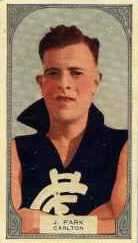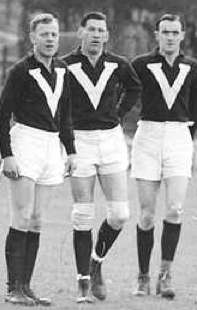Jim Park (footballer)
James William Park (14 February 1910 – 9 February 1943) was an Australian rules footballer who played with Carlton in the Victorian Football League (VFL) during the 1930s.
| Jim Park | |||
|---|---|---|---|
 | |||
| Personal information | |||
| Full name | James William Park | ||
| Date of birth | 14 February 1910 | ||
| Place of birth | Bendigo, Victoria | ||
| Date of death | 9 February 1943 (aged 32) | ||
| Place of death | Wau, Territory of New Guinea | ||
| Original team(s) | Dookie, Bass Valley | ||
| Debut |
21 May 1932, Carlton vs. Hawthorn, at Princes Park | ||
| Height | 183 cm (6 ft 0 in) | ||
| Weight | 82 kg (181 lb) | ||
| Playing career1 | |||
| Years | Club | Games (Goals) | |
| 1932–1940 | Carlton | 128 (5) | |
|
1 Playing statistics correct to the end of 1940. | |||
| Sources: AFL Tables, AustralianFootball.com | |||
He died in action, in New Guinea, whilst serving with the Second AIF.
Family
Born in Bendigo on 14 February 1910 to Dr. Alexander Park (1868-1929),[1] and Ethel Marion Park (1881-1966), née Reilly,[2] James William Park had three brothers, Alex, George, and Bob, and three sisters, Ethel, Hilda and Jean.
His father, a general practitioner, moved his practice from Bendigo (having originally practised in Tatura) to Moonee Ponds in 1919, in order to facilitate the education of his children: the boys attended Melbourne's Scotch College, which had not yet moved to Hawthorn and was still in East Melbourne, and the girls attended Melbourne's Presbyterian Ladies' College, also in East Melbourne.

He married Marjorie Jean Steele (1913-) on 26 October 1935,[3] and they had one daughter, Joan Millicent Park (later Mrs Schinner).
Education
He attended Scotch College from 1919 to 1926. He then went on to the Dookie Agricultural College, where he excelled in cricket, swimming, and football[4], as well as in his academic pursuits. In his second year he was dux of his class, and in his final year second only to the dux. He graduated from Dookie with a Diploma of Agriculture at the end of 1930.
Football
Recruited from Bass Valley Football Club, in Gippsland,[5] he received his clearance to play with Carlton on 27 April 1932,[6] and having played well for the Second XVIII on the preceding Saturday,[7] he made his senior debut for Carlton at centre half-back, against Hawthorn, on 21 May 1932 (round four).
Park played in the back pocket and was a premiership player with Carlton in 1938, restricting prolific Collingwood forward Ron Todd to three goals (two of which came from free kicks).
In the same season he was chosen to represent Victoria for the first time in his career.
.jpeg)
On Saturday, 28 May 1938, at Princes Park, in a match against Melbourne, which, although having more scoring shots, Carlton lost 14.18 (102) to 16.11 (107) — it was Carlton's first loss for the season — Park took one of the greatest marks of all time. Playing in the back pocket, in front of the Melbourne goal (having had only four yards of running space), he soared over the Melbourne forward Eric Glass, and held the mark. In the moment before the picture, Glass is erect, Park's left heel is at the level of Glass's left shoulder, his left knee is well above Glass's right shoulder, his right leg extended for balance, and the ball is a short distance away.[8]
Military service
With his occupation listed as both "clerk" and "manager", Park enlisted in the Second AIF on 12 March 1941. On Tuesday, 18 March 1941, a senior team training night, Park attended Princes Park as a guest of the Carlton Football Club committee, and "was presented with a cheque in recognition of his services to the club in the last nine years".[9]
On 9 February 1943 he was killed in action while fighting Japanese forces with the 2/6th Infantry Battalion at the Battle of Wau in New Guinea.[10]
Lieutenant Jim Park, shooting in the standing standing position a few yards from me, was shot through the heart and fell dead immediately ... He was a good soldier and a very popular officer, not least because he was such a good footballer, having been captain of a leading team in the big Melbourne league.[11]
See also
- List of Victorian Football League players who died in active service
Footnotes
- Motor Fatality, The Kilmore Free Press, (Thursday, 27 June 1929), p.2.
- Marriages: Park—Reilly, The Argus, (Thursday, 2 October 1902), p.1.
- Engagements, The Argus, (Tuesday, 14 August 1934), p.10; [ Two Players Married, The Argus, (Monday, 28 October 1935), p.13.]
- "1940 - Jim Park profile". Trove Newspapers. Sporting Globe. Retrieved 6 July 2020.
- Hobbs, 1991.
- Many Permits Granted ("J.W. Park, Bass to Carlton"), The Argus, (Thursday, 28 April 1932), p.10.
- Football: League Seconds: Carlton, 18–12 d. Richmond, 10–13, The Argus, (Monday, 16 May 1932), p.15.
- That (earlier) photograph can be seen at Main and Allen (2002), p.309.
- Presentation to Park, The Argus, (Wednesday, 18 March 1941), p.12.
- ww2roll.gov.au
- Henry “Jo” Gullett (1992), Good Company; Horseman, Soldier, Politician, Brisbane, University of Queensland Press, p.176. ISBN 0-7022-2443-X
References
- Hobbs, G., "Jim Park", Football Record, (25–28 April 1991), p. 15.
- Main, J. & Allen, D., "Park, Jim", pp. 307–310 in Main, J. & Allen, D., Fallen — The Ultimate Heroes: Footballers Who Never Returned From War, Crown Content, (Melbourne), 2002. ISBN 1-74095-010-0
- Engagements: Marjorie Jean Steele to James William Park, The Argus, (Tuesday, 14 August 1934), p.10.
- Victorians in Army Casualty List: Australia and the Islands: Killed in Action: Park, J.W., The Argus, (Thursday, 25 February 1943), p.4.
- Deaths: On Active Service: Park, The Argus, (Saturday, 6 March 1943), p.2.
- Deaths: On Active Service: Park (inserted on behalf of the committee, players, and staff of the Carlton Football Club), The Age, (Monday, 8 March 1943), p.5.
- Football: CarltonPlayer Killed, The Age, (Monday, 8 March 1943), p.4.
- Carlton Footballer Killed (Obituary), The Argus, (Monday, 8 March 1943), p.3.
- De Bolfo, T., "Peter’s PNG pilgrimage to Jim Park’s grave", AFL.COM, Tuesday, 27 April 2010. at Archive.today (archived 2012-11-30)
External links
| Wikimedia Commons has media related to Jim Park (footballer). |
- Jim Park's playing statistics from AFL Tables
- Jim Park at AustralianFootball.com
- Blueseum Biography: Jim Park
- Jim Park, Boyles Football Photos.
- Australian War World War II Service Record: James William Park
- Australian War Memorial Roll of Honour: James William Park (VX51193)
- World War II Nominal Roll: James William Park (VX51193)
- Commonwealth War Graves Commission Record: James William Park (VX51193)